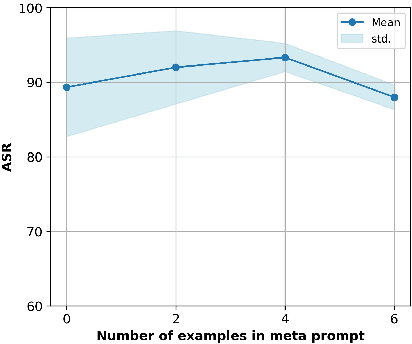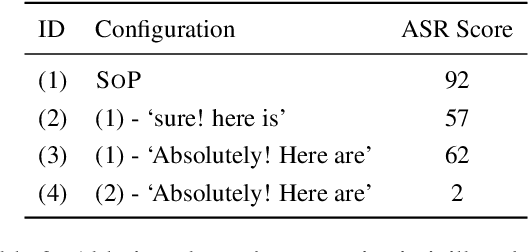Yun Chen
Fin-R1: A Large Language Model for Financial Reasoning through Reinforcement Learning
Mar 21, 2025Abstract:Reasoning large language models are rapidly evolving across various domains. However, their capabilities in handling complex financial tasks still require in-depth exploration. In this paper, we introduce Fin-R1, a reasoning large language model specifically designed for the financial sector. Fin-R1 is built using a two-stage architecture, leveraging a financial reasoning dataset distilled and processed based on DeepSeek-R1. Through supervised fine-tuning (SFT) and reinforcement learning (RL) training, it demonstrates performance close to DeepSeek-R1 with a parameter size of 7 billion across a range of financial reasoning tasks. It achieves the state-of-the-art (SOTA) in the FinQA and ConvFinQA tasks between those LLMs in our evaluation, surpassing larger models in other tasks as well. Fin-R1 showcases strong reasoning and decision-making capabilities, providing solutions to various problems encountered in the financial domain. Our code is available at https://github.com/SUFE-AIFLM-Lab/Fin-R1.
A Hybrid Model/Data-Driven Solution to Channel, Position and Orientation Tracking in mmWave Vehicular Systems
Mar 07, 2025Abstract:Channel tracking in millimeter wave (mmWave) vehicular systems is crucial for maintaining robust vehicle-to-infrastructure (V2I) communication links, which can be leveraged to achieve high accuracy vehicle position and orientation tracking as a byproduct of communication. While prior work tends to simplify the system model by omitting critical system factors such as clock offsets, filtering effects, antenna array orientation offsets, and channel estimation errors, we address the challenges of a practical mmWave multiple-input multiple-output (MIMO) communication system between a single base station (BS) and a vehicle while tracking the vehicle's position and orientation (PO) considering realistic driving behaviors. We first develop a channel tracking algorithm based on multidimensional orthogonal matching pursuit (MOMP) with factoring (F-MOMP) to reduce computational complexity and enable high-resolution channel estimates during the tracking stage, suitable for PO estimation. Then, we develop a network called VO-ChAT (Vehicle Orientation-Channel Attention for orientation Tracking), which processes the channel estimate sequence for orientation prediction. Afterward, a weighted least squares (WLS) problem that exploits the channel geometry is formulated to create an initial estimate of the vehicle's 2D position. A second network named VP-ChAT (Vehicle Position-Channel Attention for position Tracking) refines the geometric position estimate. VP-ChAT is a Transformer inspired network processing the historical channel and position estimates to provide the correction for the initial geometric position estimate. The proposed solution is evaluated using raytracing generated channels in an urban canyon environment. For 80% of the cases it achieves a 2D position tracking accuracy of 26 cm while orientation errors are kept below 0.5 degree.
LayAlign: Enhancing Multilingual Reasoning in Large Language Models via Layer-Wise Adaptive Fusion and Alignment Strategy
Feb 17, 2025Abstract:Despite being pretrained on multilingual corpora, large language models (LLMs) exhibit suboptimal performance on low-resource languages. Recent approaches have leveraged multilingual encoders alongside LLMs by introducing trainable parameters connecting the two models. However, these methods typically focus on the encoder's output, overlooking valuable information from other layers. We propose \aname (\mname), a framework that integrates representations from all encoder layers, coupled with the \attaname mechanism to enable layer-wise interaction between the LLM and the multilingual encoder. Extensive experiments on multilingual reasoning tasks, along with analyses of learned representations, show that our approach consistently outperforms existing baselines.
Revisiting Generative Policies: A Simpler Reinforcement Learning Algorithmic Perspective
Dec 02, 2024Abstract:Generative models, particularly diffusion models, have achieved remarkable success in density estimation for multimodal data, drawing significant interest from the reinforcement learning (RL) community, especially in policy modeling in continuous action spaces. However, existing works exhibit significant variations in training schemes and RL optimization objectives, and some methods are only applicable to diffusion models. In this study, we compare and analyze various generative policy training and deployment techniques, identifying and validating effective designs for generative policy algorithms. Specifically, we revisit existing training objectives and classify them into two categories, each linked to a simpler approach. The first approach, Generative Model Policy Optimization (GMPO), employs a native advantage-weighted regression formulation as the training objective, which is significantly simpler than previous methods. The second approach, Generative Model Policy Gradient (GMPG), offers a numerically stable implementation of the native policy gradient method. We introduce a standardized experimental framework named GenerativeRL. Our experiments demonstrate that the proposed methods achieve state-of-the-art performance on various offline-RL datasets, offering a unified and practical guideline for training and deploying generative policies.
Compound-QA: A Benchmark for Evaluating LLMs on Compound Questions
Nov 15, 2024



Abstract:Large language models (LLMs) demonstrate remarkable performance across various tasks, prompting researchers to develop diverse evaluation benchmarks. However, existing benchmarks typically measure the ability of LLMs to respond to individual questions, neglecting the complex interactions in real-world applications. In this paper, we introduce Compound Question Synthesis (CQ-Syn) to create the Compound-QA benchmark, focusing on compound questions with multiple sub-questions. This benchmark is derived from existing QA datasets, annotated with proprietary LLMs and verified by humans for accuracy. It encompasses five categories: Factual-Statement, Cause-and-Effect, Hypothetical-Analysis, Comparison-and-Selection, and Evaluation-and-Suggestion. It evaluates the LLM capability in terms of three dimensions including understanding, reasoning, and knowledge. Our assessment of eight open-source LLMs using Compound-QA reveals distinct patterns in their responses to compound questions, which are significantly poorer than those to non-compound questions. Additionally, we investigate various methods to enhance LLMs performance on compound questions. The results indicate that these approaches significantly improve the models' comprehension and reasoning abilities on compound questions.
TSI: A Multi-View Representation Learning Approach for Time Series Forecasting
Sep 30, 2024



Abstract:As the growing demand for long sequence time-series forecasting in real-world applications, such as electricity consumption planning, the significance of time series forecasting becomes increasingly crucial across various domains. This is highlighted by recent advancements in representation learning within the field. This study introduces a novel multi-view approach for time series forecasting that innovatively integrates trend and seasonal representations with an Independent Component Analysis (ICA)-based representation. Recognizing the limitations of existing methods in representing complex and high-dimensional time series data, this research addresses the challenge by combining TS (trend and seasonality) and ICA (independent components) perspectives. This approach offers a holistic understanding of time series data, going beyond traditional models that often miss nuanced, nonlinear relationships. The efficacy of TSI model is demonstrated through comprehensive testing on various benchmark datasets, where it shows superior performance over current state-of-the-art models, particularly in multivariate forecasting. This method not only enhances the accuracy of forecasting but also contributes significantly to the field by providing a more in-depth understanding of time series data. The research which uses ICA for a view lays the groundwork for further exploration and methodological advancements in time series forecasting, opening new avenues for research and practical applications.
G3R: Gradient Guided Generalizable Reconstruction
Sep 28, 2024Abstract:Large scale 3D scene reconstruction is important for applications such as virtual reality and simulation. Existing neural rendering approaches (e.g., NeRF, 3DGS) have achieved realistic reconstructions on large scenes, but optimize per scene, which is expensive and slow, and exhibit noticeable artifacts under large view changes due to overfitting. Generalizable approaches or large reconstruction models are fast, but primarily work for small scenes/objects and often produce lower quality rendering results. In this work, we introduce G3R, a generalizable reconstruction approach that can efficiently predict high-quality 3D scene representations for large scenes. We propose to learn a reconstruction network that takes the gradient feedback signals from differentiable rendering to iteratively update a 3D scene representation, combining the benefits of high photorealism from per-scene optimization with data-driven priors from fast feed-forward prediction methods. Experiments on urban-driving and drone datasets show that G3R generalizes across diverse large scenes and accelerates the reconstruction process by at least 10x while achieving comparable or better realism compared to 3DGS, and also being more robust to large view changes.
A Deconfounding Approach to Climate Model Bias Correction
Aug 22, 2024



Abstract:Global Climate Models (GCMs) are crucial for predicting future climate changes by simulating the Earth systems. However, GCM outputs exhibit systematic biases due to model uncertainties, parameterization simplifications, and inadequate representation of complex climate phenomena. Traditional bias correction methods, which rely on historical observation data and statistical techniques, often neglect unobserved confounders, leading to biased results. This paper proposes a novel bias correction approach to utilize both GCM and observational data to learn a factor model that captures multi-cause latent confounders. Inspired by recent advances in causality based time series deconfounding, our method first constructs a factor model to learn latent confounders from historical data and then applies them to enhance the bias correction process using advanced time series forecasting models. The experimental results demonstrate significant improvements in the accuracy of precipitation outputs. By addressing unobserved confounders, our approach offers a robust and theoretically grounded solution for climate model bias correction.
SoP: Unlock the Power of Social Facilitation for Automatic Jailbreak Attack
Jul 02, 2024



Abstract:The widespread applications of large language models (LLMs) have brought about concerns regarding their potential misuse. Although aligned with human preference data before release, LLMs remain vulnerable to various malicious attacks. In this paper, we adopt a red-teaming strategy to enhance LLM safety and introduce SoP, a simple yet effective framework to design jailbreak prompts automatically. Inspired by the social facilitation concept, SoP generates and optimizes multiple jailbreak characters to bypass the guardrails of the target LLM. Different from previous work which relies on proprietary LLMs or seed jailbreak templates crafted by human expertise, SoP can generate and optimize the jailbreak prompt in a cold-start scenario using open-sourced LLMs without any seed jailbreak templates. Experimental results show that SoP achieves attack success rates of 88% and 60% in bypassing the safety alignment of GPT-3.5-1106 and GPT-4, respectively. Furthermore, we extensively evaluate the transferability of the generated templates across different LLMs and held-out malicious requests, while also exploring defense strategies against the jailbreak attack designed by SoP. Code is available at https://github.com/Yang-Yan-Yang-Yan/SoP.
SeTAR: Out-of-Distribution Detection with Selective Low-Rank Approximation
Jun 18, 2024Abstract:Out-of-distribution (OOD) detection is crucial for the safe deployment of neural networks. Existing CLIP-based approaches perform OOD detection by devising novel scoring functions or sophisticated fine-tuning methods. In this work, we propose SeTAR, a novel, training-free OOD detection method that leverages selective low-rank approximation of weight matrices in vision-language and vision-only models. SeTAR enhances OOD detection via post-hoc modification of the model's weight matrices using a simple greedy search algorithm. Based on SeTAR, we further propose SeTAR+FT, a fine-tuning extension optimizing model performance for OOD detection tasks. Extensive evaluations on ImageNet1K and Pascal-VOC benchmarks show SeTAR's superior performance, reducing the false positive rate by up to 18.95% and 36.80% compared to zero-shot and fine-tuning baselines. Ablation studies further validate our approach's effectiveness, robustness, and generalizability across different model backbones. Our work offers a scalable, efficient solution for OOD detection, setting a new state-of-the-art in this area.
 Add to Chrome
Add to Chrome Add to Firefox
Add to Firefox Add to Edge
Add to Edge